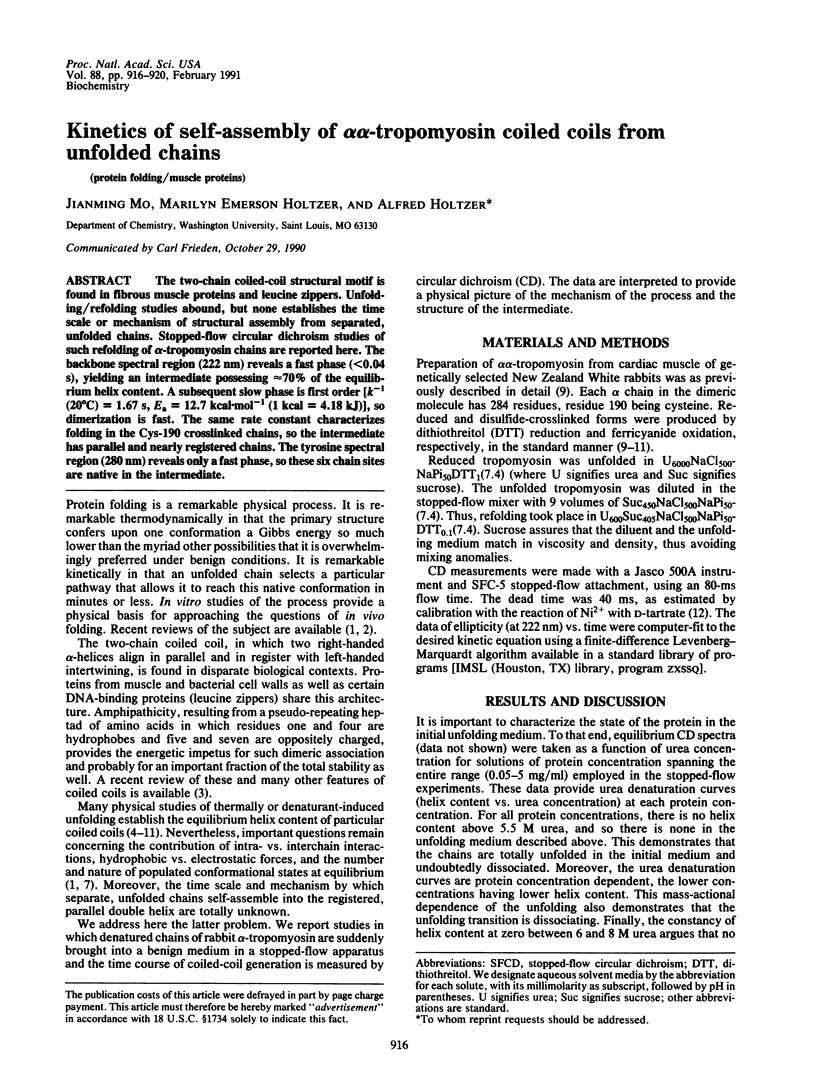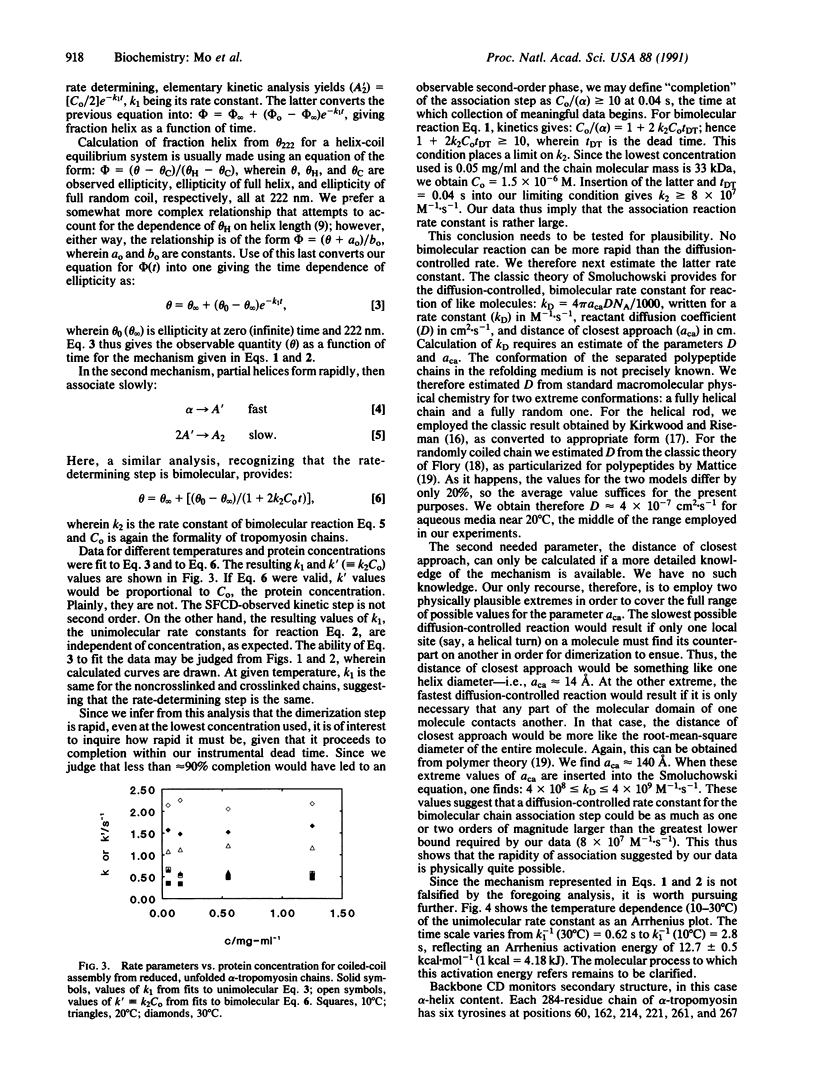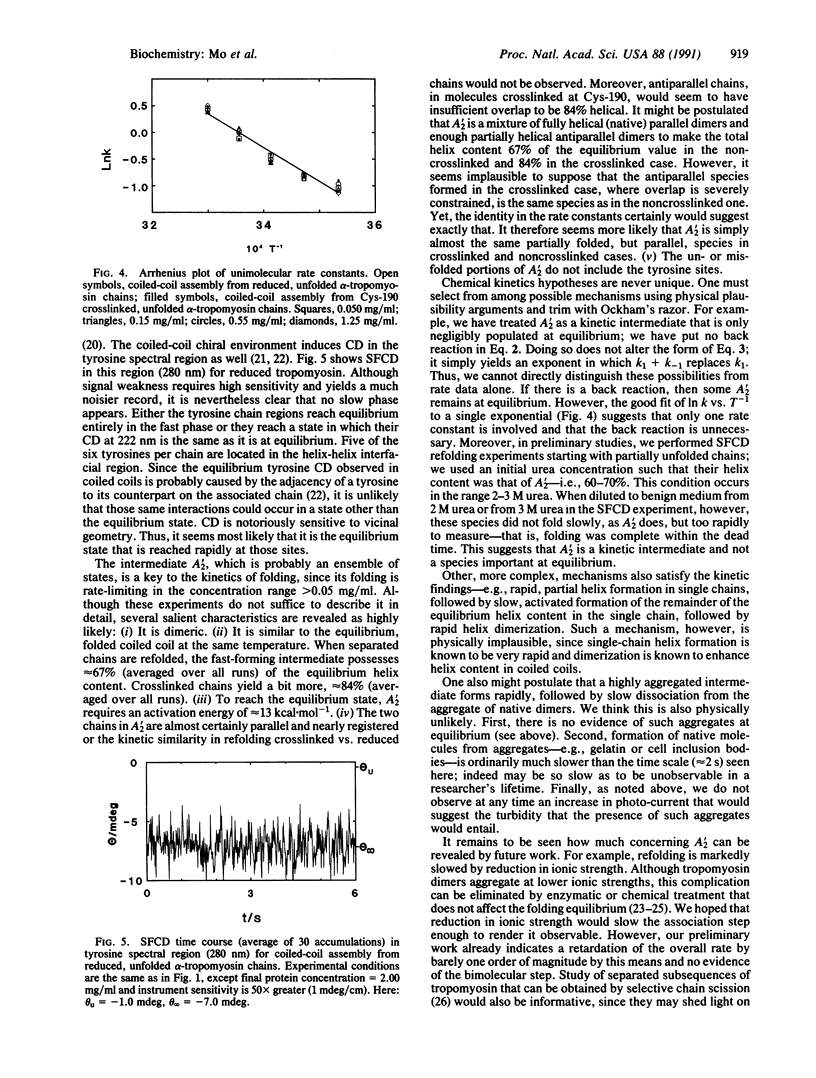Abstract
The two-chain coiled-coil structural motif is found in fibrous muscle proteins and leucine zippers. Unfolding/refolding studies abound, but none establishes the time scale or mechanism of structural assembly from separated, unfolded chains. Stopped-flow circular dichroism studies of such refolding of alpha-tropomyosin chains are reported here. The backbone spectral region (222 nm) reveals a fast phase (less than 0.04 s), yielding an intermediate possessing approximately 70% of the equilibrium helix content. A subsequent slow phase is first order [k-1 (20 degrees C) = 1.67 s, Ea = 12.7 kcal.mol-1 (1 kcal = 4.18 kJ)], so dimerization is fast. The same rate constant characterizes folding in the Cys-190 crosslinked chains, so the intermediate has parallel and nearly registered chains. The tyrosine spectral region (280 nm) reveals only a fast phase, so these six chain sites are native in the intermediate.
Full text
PDF




Selected References
These references are in PubMed. This may not be the complete list of references from this article.
- Bracken W. C., Carey J., Holtzer M. E., Holtzer A. Alpha-helix-to-random-coil transitions of two-chain coiled coils: experiments on the thermal denaturation of beta beta tropomyosin cross-linked selectively at C-190. Biopolymers. 1988 Aug;27(8):1223–1237. doi: 10.1002/bip.360270804. [DOI] [PubMed] [Google Scholar]
- Bullard B., Mercola D. A., Mommaerts W. F. The origin of the tyrosyl circular dichroism of tropomyosin. Biochim Biophys Acta. 1976 May 20;434(1):90–99. doi: 10.1016/0005-2795(76)90038-6. [DOI] [PubMed] [Google Scholar]
- Chao Y. Y., Holtzer A. Spin-label studies of tropomyosin. Biochemistry. 1975 May 20;14(10):2164–2170. doi: 10.1021/bi00681a019. [DOI] [PubMed] [Google Scholar]
- Cohen C., Parry D. A. Alpha-helical coiled coils and bundles: how to design an alpha-helical protein. Proteins. 1990;7(1):1–15. doi: 10.1002/prot.340070102. [DOI] [PubMed] [Google Scholar]
- Cummins P., Perry S. V. The subunits and biological activity of polymorphic forms of tropomyosin. Biochem J. 1973 Aug;133(4):765–777. doi: 10.1042/bj1330765. [DOI] [PMC free article] [PubMed] [Google Scholar]
- Graceffa P., Lehrer S. S. Tropomyosin's end-to-end polymerization is irreversibly lost on exposure to urea or cyanate. Biochem Biophys Res Commun. 1986 Jan 14;134(1):64–70. doi: 10.1016/0006-291x(86)90527-9. [DOI] [PubMed] [Google Scholar]
- Kuwajima K. The molten globule state as a clue for understanding the folding and cooperativity of globular-protein structure. Proteins. 1989;6(2):87–103. doi: 10.1002/prot.340060202. [DOI] [PubMed] [Google Scholar]
- Lehrer S. S. Effects of an interchain disulfide bond on tropomyosin structure: intrinsic fluorescence and circular dichroism studies. J Mol Biol. 1978 Jan 15;118(2):209–226. doi: 10.1016/0022-2836(78)90413-8. [DOI] [PubMed] [Google Scholar]
- Mak A. S., Smillie L. B. Non-polymerizable tropomyosin: preparation, some properties and F-actin binding. Biochem Biophys Res Commun. 1981 Jul 16;101(1):208–214. doi: 10.1016/s0006-291x(81)80032-0. [DOI] [PubMed] [Google Scholar]
- Mak A. S., Smillie L. B., Stewart G. R. A comparison of the amino acid sequences of rabbit skeletal muscle alpha- and beta-tropomyosins. J Biol Chem. 1980 Apr 25;255(8):3647–3655. [PubMed] [Google Scholar]
- Mattice W. L. Unperturbed dimensions of disordered proteins containing an interchain disulfide cross-link. Macromolecules. 1977 May-Jun;10(3):516–520. doi: 10.1021/ma60057a003. [DOI] [PubMed] [Google Scholar]
- Mo J. M., Holtzer M. E., Holtzer A. The thermal denaturation of nonpolymerizable alpha alpha-tropomyosin and its segments as a function of ionic strength. Biopolymers. 1990;30(9-10):921–927. doi: 10.1002/bip.360300907. [DOI] [PubMed] [Google Scholar]
- Noda A., Noda H., Ohno K., Sendo T., Misaka A., Kanazawa Y., Isobe R., Hirata M. Spin trapping of a free radical intermediate formed during microsomal metabolism of hydrazine. Biochem Biophys Res Commun. 1985 Dec 31;133(3):1086–1091. doi: 10.1016/0006-291x(85)91247-1. [DOI] [PubMed] [Google Scholar]
- O'Shea E. K., Rutkowski R., Kim P. S. Evidence that the leucine zipper is a coiled coil. Science. 1989 Jan 27;243(4890):538–542. doi: 10.1126/science.2911757. [DOI] [PubMed] [Google Scholar]
- Pato M. D., Mak A. S., Smillie L. B. Fragments of rabbit striated muscle alpha-tropomyosin. I. Preparation and characterization. J Biol Chem. 1981 Jan 25;256(2):593–601. [PubMed] [Google Scholar]
- Privalov P. L. Stability of proteins. Proteins which do not present a single cooperative system. Adv Protein Chem. 1982;35:1–104. [PubMed] [Google Scholar]
- Ptitsyn O. B., Pain R. H., Semisotnov G. V., Zerovnik E., Razgulyaev O. I. Evidence for a molten globule state as a general intermediate in protein folding. FEBS Lett. 1990 Mar 12;262(1):20–24. doi: 10.1016/0014-5793(90)80143-7. [DOI] [PubMed] [Google Scholar]
- Woods E. F. Studies on the denaturation of tropomyosin and light meromyosin. Int J Protein Res. 1969;1(1):29–43. doi: 10.1111/j.1399-3011.1969.tb01624.x. [DOI] [PubMed] [Google Scholar]


